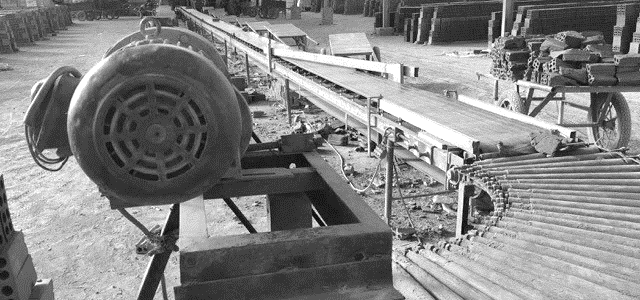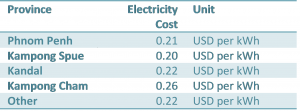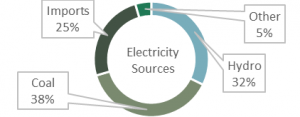Energy Efficiency – Cambodia’s Industrial Sector
Energy Efficiency improves a firm’s competitiveness (less cost) and the environment we all share (less emissions). This blog post summarizes the energy and energy efficiency situation in Cambodia. It’s a summary of the initial phase of a pre-feasibility study (PFS) for a ‘fund‘ to encourage Cambodian SME to invest in energy efficiency.
EMC completed the original study for the National Council for Sustainable Development (Royal Government of Cambodia) and the Global Green Growth Institute. The study was motivated by the earlier Phnom Penh Green City Strategic Plan completed in 2016. We worked with Arup, the global engineering consulting firm, to specify and analyse the financial and environmental returns to energy efficiency technologies. Here’s a FB post and photos from the final workshop.
From the same project, here’s also a blog post on Cambodia’s ‘Green Growth’ policy framework.
Why Encourage Energy Efficiency
It has long been recognized that, due to the slow uptake of emissions-free energy generation technology, a significant share of international climate change mitigation efforts should focus on reducing energy demand. In most cases, this means enforcing energy efficiency and energy conservation measures, so that human activities become less energy intensive. Energy efficiency almost always makes sense from an economic point of view, since it reduces the amount of input (energy) required to generate a given output (goods and services, economic growth, etc.), thus increasing the total surplus captured by individuals, companies and the economy as a whole. The promotion of energy efficiency measures can therefore be counted as an appropriate “Green Growth” strategy for emerging countries that wish to contribute to the climate mitigation effort, without compromising their social and economic development goals.
Cambodia’s CO2 emissions (at 1.96 Mt-C in 2013) are currently very low compared to other countries like Thailand (60.2 Mt-C in 2013). However this is expected to rise, as GDP and energy consumption rises. Consequently Cambodia’s total energy consumption is forecast to increase from 6.00 Mtoe in 2013 to 14.29 Mtoe in 2040, at an average annual rate of 3.3% (Kimura & Phoumin, 2016).
Currently, therefore, Royal Government of Cambodia has the opportunity to take appropriate measures to avoid ‘locking in’ its current energy-intensive growth trajectory and, to the extent possible, attempt to de-couple economic development from CO2 emissions (Kimura & Phoumin, 2016).
Our PFS focussed on the industrial and commercial sectors. These do not account for the biggest share of energy consumption in Cambodia, but do account for much of the country’s actual and potential economic growth and will therefore play a key role in Cambodia’s transition towards a competitive and green economy.
Energy Mix in the Cambodian Industrial Sector
Traditional biomass is the most important source of energy in the Cambodian industrial sector, but the consumption of electricity is increasing and accounts for a disproportionate share of SMEs costs.
The industrial sector consumes most of its energy from biomass (58 per cent of industrial TFEC), followed by petroleum products (21 per cent) and electricity (18 per cent). However, the cost of electricity from the Cambodian national grid is higher than in all other South-East Asian countries (see Table Industrial Electricity Tariff) and consequently electricity accounts for a disproportionate share of SMEs’ costs. In addition to this, SMEs frequently need to use diesel or heavy fuel-oil (HFO) generators to avoid disruption to their production processes whenever the grid goes offline.
Only 14 per cent of all energy consumption in Cambodia takes the form of electricity, but grid coverage is expanding and electricity accounts for a growing share of energy consumption. Over 32 per cent of Cambodia’s electricity supply comes from hydropower, a more carbon-neutral and renewable source of energy (see Table Electricity Sources). Expanding grid access and improving the reliability of the grid would allow SMEs to reduce their reliance on back-up generators, and would almost certainly reduce their carbon-intensity. However, it would also require investments in electricity generation capacity, which in recent years has meant the construction of coal plants. Electrification should therefore be complemented by EE investment, to reduce overall energy demand and the carbon-intensity of the economy.
Our PFS therefore focussed on EE initiatives that address both on biomass and electricity consumption, in order to improve both the traditional processes that are still dominant in the country, and the electricity-based processes that are likely to become more prevalent in the future.
SME Energy Savings Potential
In general, there seems to be very large potential for energy savings in the industrial and commercial sectors. Research commissioned by the EUEI-PDF estimated potential energy savings ranging from 15 per cent to 70 per cent, depending on the subsector (MME & EUEI-PDF, 2013). Stakeholder interviews confirmed that SMEs can achieve double-digit energy cost savings – with average payback periods as low as 18 months – if suitable EE investments are made (Source: IEEC). Expert opinions suggest that, in most cases, potential cost savings are higher than the commercial interest rates that prevail in the Cambodian market for SME loans (of between 11 to 16 per cent). This suggests that;
- There is a strong business case for debt-funded EE investment, and that concessional finance may not be needed to achieve these savings.
- Helping firms target the most suitable EE investments should be a critical component of any scheme
Likely Energy Efficiency Investments
EE solutions with the most potential in the selected subsectors include: switching fuel sources, upgrading thermal energy generation machines, upgrading electrical equipment. Thermal energy plays an important role in the industrial sector – cost savings can be achieved by switching to more cost-effective fuel sources (such as wood, rice husk) or by using more efficient machines (boilers, kilns). Other energy efficiency measures, like replacement of variable speed drive and efficient lighting can also lead to significant reductions in energy usage. Cross-cutting measures that could be applied in most or all of the target subsectors have been summarised as follows:
| 1. Switching to bio-fuels for thermal and electricity generation, e.g. using wood or rice husk. |
| 2. Upgrading to more efficient thermal energy generation machines, e.g. boiler, kilns. |
| 3. Upgrading to more efficient electricity consumption equipment, e.g. motor-machine, lightings |
Selected Sectors
Ultimately we selected four subsectors for further analysis in the PFS: garment manufacturing, rice milling, brick manufacturing, and hotels. Information on these subsectors is readily available, due to existing research and development projects (in particular UNIDO). The selected subsectors are also significant energy consumers in Cambodia and the EE measures proposed for each subsector would be an effective approach to improving EE and reducing GHG emissions.
Next Steps
Much of the above, is based on technical data; domestic, and international. It confirmed the development hypothesis, that in theory, Cambodian SME should invest in energy efficiency.
In a subsequent blog we cover why SMEs are reluctant to invest in energy efficiency, and how an appropriate fund design can encourage them to do so. In other posts we detail the financial and environmental returns to investing in energy efficiency.



[…] Currently, Cambodia’s pollution rate is lower than in neighboring countries with only 1.96 megatons of CO2 emissions annually compared with 6 megatons in Thailand. This is expected to rise at a rate of 3.3% per year. The […]